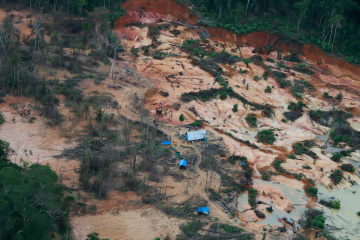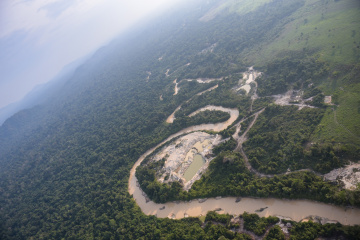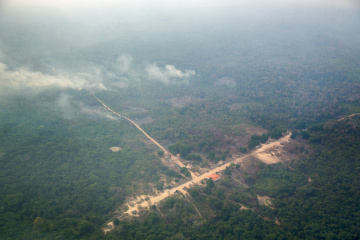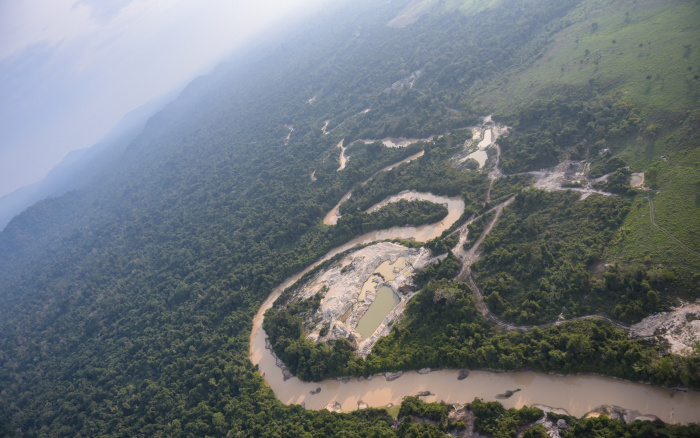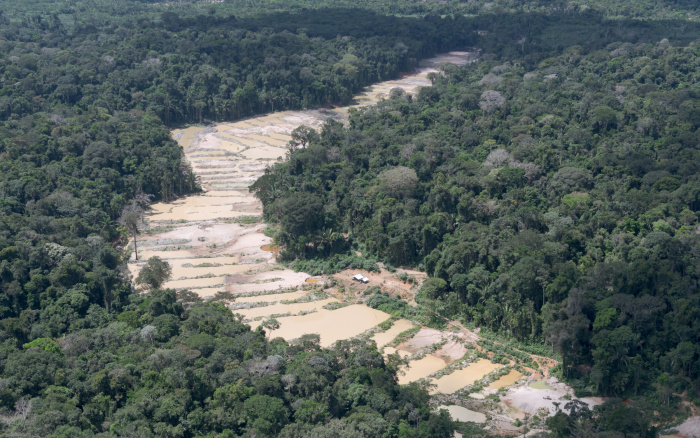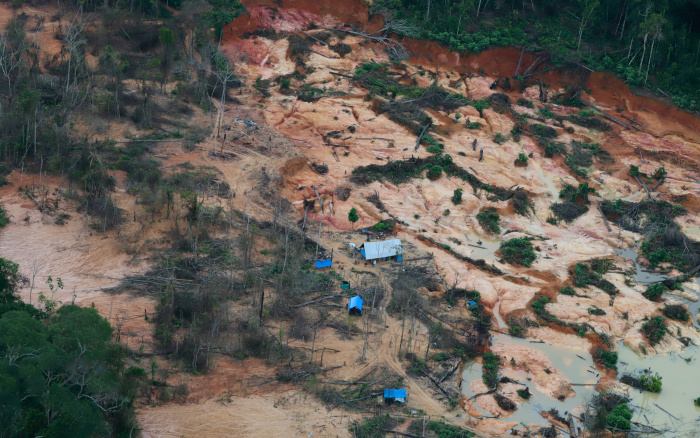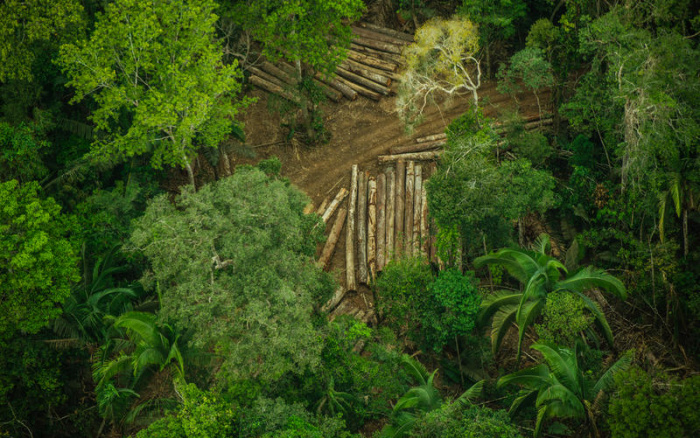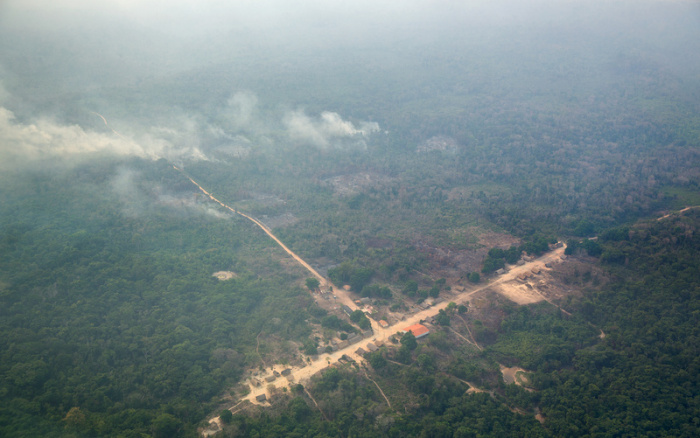Você está na versão anterior do website do ISA
Atenção
Essa é a versão antiga do site do ISA que ficou no ar até março de 2022. As informações institucionais aqui contidas podem estar desatualizadas. Acesse https://www.socioambiental.org para a versão atual.
Deforestation and Covid-19 Soar in the Amazon’s Most Invaded Indigenous Lands
terça-feira, 08 de Setembro de 2020 
Esta notícia está associada ao Programa:
Devastation grew by 827% in the Trincheira-Bacajá Indigenous Land (PA), according to an ISA survey. After six months of the pandemic, the government still has no plan to contain Covid-19 among indigenous people
Editing and reporting: Clara Roman and Oswaldo Braga de Souza
Research and data analysis: Antonio Oviedo e Tiago Moreira dos Santos
Land-grabbers (known as grileiros), illegal miners (garimpeiros) and loggers do not work from home. During the pandemic, invasions of Indigenous Lands (TIs) have grown exponentially, increasing the risk and spread of Covid-19 among their populations, without action or even adequate planning from the government to contain the problem, six months since the health crisis began.
In the Trincheira-Bacajá, Kayapó and Mundurucu TIs, in southwestern Pará, deforestation has increased by 827%, 420% and 238% respectively, between March and July. They are among the seven most invaded homologated lands (with complete demarcation) in the Legal Amazon, along with the Karipuna and Uru-Eu-Wau-Wau (RO), Araribóia (MA) and Yanomami (AM/RR) TIs. In the period of the arrival and growth of the epidemic in the country, 2,400 hectares of forest have been destroyed in these seven areas, or the equivalent to 15 times the Ibirapuera Park in São Paulo.
The survey was conducted by ISA and based on the Real Time Deforestation Detection System (DETER) of the National Institute for Space Research (Inpe), and the Radar Deforestation Indicator System (SIRAD) of the Xingu+ organisation network. The data captures clear-cutting, which is the complete destruction of vegetation, for land-grabbing, farming and illegal mining.
Cases of Covid-19 have soared in these territories. In the Special Indigenous Sanitary Districts (DSEIs) that serve the Karipuna, Yanomami and Kayapó TIs, records have jumped by 355%, 215% and 138% respectively, between 7/7 and 29/8. The DSEIs of the seven areas total more than five thousand cases so far.
Although served by the Porto Velho DSEI, as is the Karipuna TI, the Uru-Eu-Wau-Wau TI (RO) is the only one of the seven lands with no record of the disease, according to information from the Kanindé Ethno-environmental Defence Association. Generally, each DSEI serves more than one territory, but the Special Secretariat for Indigenous Health (SESAI), which is subordinated to the Ministry of Health and to which the districts are linked, does not disclose data by TI.
The municipalities that span the seven territories, where the invaders are circulating, already account for at least 64,700 cases. In Nova Mamoré and Porto Velho (RO) alone, where the Karipuna TI is located, there are 24,400 cases. The data on municipalities is from the Brasil.io platform.
The situation tends to be worse. There are reservations about Sesai statistics, as with all official estimates of the epidemic in the country, due to underreporting. The indigenous movement has criticised the organ’s lack of testing and transparency. Furthermore, since the beginning of the health crisis, the secretariat and the SUS have not reported cases and deaths of indigenous people in cities. While Sesai has reported 380 deaths and 23,100 cases, last Monday (31st August) the Committee for Indigenous Life and Memory of the Articulation of Indigenous Peoples of Brazil (APIB) reported 757 lives lost, over 28,800 cases and 156 peoples affected.
STF Ruling and the Controversy of Extrusion
The request for the withdrawal of the invaders (extrusion) from the seven TIs is part of the emergency measures requested in the Claim of Non-Compliance with a Fundamental Precept (ADPF) presented to the Supreme Federal Court (STF) by the APIB in June. This type of action seeks to avoid or repair damage to a basic principle of the Constitution resulting from an act or omission of the State.
On 7th July, Minister Luís Roberto Barroso granted an injunction fulfilling almost all the requests made in the ADPF. Initially, it was stipulated that the government should only “contain and isolate” invaders. “I am rejecting for the time being the request to withdraw the invaders in view of the risk they may pose to the life, health and safety of the communities,” he stated. Barroso made a caveat, however: “it is the Union’s duty to address the problem of invasions and develop a disintrusion plan”. He added that if this was not done within a reasonable time, he could take further action.
The minister also determined that the federal administration guarantee assistance to indigenous people in the countryside and the city, in TIs with completed and incomplete demarcation, the implementation of sanitary barriers in areas with isolated and recently contacted groups and the creation of a ‘situation room’ for defining strategies for these communities. The decision also established a working group formed of government representatives, indigenous peoples, the Federal Public Ministry (MPF), among others, to propose a general plan to fight Covid-19 among communities throughout Brazil (learn more).
Almost a month later, the STF plenary fully endorsed the injunction. The controversy was over the issue of invasions. The lawyers who spoke on behalf of APIB recalled the threat of genocide to the isolated - generally small groups located in remote areas, making it difficult to remove patients, and who could be exterminated in a short time by a rapidly spreading virus. Ministers Edson Fachin and Ricardo Lewandowski insisted on the urgency of the extrusions and even suggested deadlines for operations, but lost the vote.
Rejecting the request to withdraw the invaders, Minister Alexandre de Moraes argued that psychologists and social workers would be needed alongside the police forces, because of the presence of families, women and children in the invasions. The Attorney General of the Union, José Levi Mello do Amaral Júnior, went on to argue that the large number of people, public agencies and instances involved would require a Law and Order Guarantee (GLO) operation to be decreed (learn more).
“I do not know the data on which he [the Attorney General] based himself to say that, but I agree with the assertion that disintrusion operations have been carried out without this need [for a GLO]”, countered attorney Eliana Torelly, coordinator of the 6th MPF Chamber which deals with indigenous rights. “I think it is a matter of providing the supervisory bodies with a better structure”, she argued.
Working Group
On 21st August, in a dispatch, Barroso accepted criticisms and requests from APIB and its specialist advisors regarding the first version of the general plan for facing Covid-19 presented by the federal administration. The document listed actions already taken without proposing future initiatives with objectives, goals and indicators. Barroso set 7th September as the deadline for the presentation of a new version of the text and said he would create another working group on the issue of extrusion, but only after the general and isolated plans had been approved. By the Minister’s determination, the government handed over epidemiological and assistance data on indigenous territories last Friday (28th August).
“We are not making headway due to the inefficiency of the technical body of the Bolsonaro government. It is not only inefficiency, but also a position of not doing things effectively”, was the criticism made by Luís Eloy Terena, an Apib lawyer. The entity has drawn up a document summarising the actions that must be taken in each of the seven areas to neutralise the invasions.
Extrusion is viable during the pandemic, say technicians and MPF
The size and complexity of an extrusion could involve the Federal Police (PF), the Brazilian Institute of the Environment (IBAMA), the State Police, the National Force or the Army, in addition to the National Indian Foundation (FUNAI). When the scale of the action is very large, it can involve different ministries and be coordinated by one of them, such as the Ministry of Justice, or the Casa Civil.
Prosecutor Eliana Torelly considers that, in his decision, Minister Barroso sought to give the government time to calmly organise the actions, but agrees that it is possible to make them feasible at this time. “Often, the operations for removing these people are easier than installing barriers”, she said.
IBAMA and FUNAI technicians confirm that it is possible to carry out operations immediately, provided that appropriate health and safety protocols are followed. They explain that there are different situations in the seven areas, requiring equally specific actions. In the case of wood theft, and small and medium scale mining or garimpo, there is generally no permanent occupation and the number of invaders is lower. In these cases, a few dozen agents and the financial resources of IBAMA, FUNAI and the PF would suffice.
Officials stress that even in the most complex case, of the Yanomami TI, where there are around 20,000 garimpeiros, with enough planning and investment in intelligence, actions can be initiated to strangle the fuel, food and input supplies of the intruders, forcing them to withdraw from the territory, without contact with inspectors and police.
“An inspection operation to destructure a garimpo is much simpler than going in to remove families”, says an IBAMA agent with 15 years of experience, including in coordination positions, who preferred not to be identified.
He recalls that, in the past, before the pandemic, the complexity of operations and the number of invaders had already been used as an excuse for inaction. “Am I giving personal protective equipment to staff? Am I taking care of the staff? If, in fact, you are not, then you cannot expose staff to a greater risk. But if you provide the sufficient conditions for acting, then it is a legal obligation”, he concludes.
“It is not impossible to do it in an organised way”, says an official who has worked for FUNAI for 10 years and has experience fighting invasions. “Bank robberies are happening everywhere. The police have not stopped acting in the city. It is much simpler to do an operation like this one, in a broad area and in the open”, he says.
He further assesses that, in general, the risk of contamination for the communities is low. “You can create contingency plans, protocols, [have] good interpreters who do not come close, differentiated food. The invaders are usually not among the community. A risk analysis can be made”, he explains.
Two relatively small and inexpensive operations are cited as successful cases. In the first, in September last year, 60 PF, IBAMA and FUNAI agents destroyed 60 rafts used by miners in the Vale do Javari TI (AM). In the second operation, in the Ituna-Itatá TI, between the end of 2019 and April this year, a small group of IBAMA inspectors and military police were able to reduce deforestation to zero, after the area had reached record levels in recent years. The two officials heard by the report also stressed that it is necessary to set up permanent bases in the regions of the most invaded TIs to prevent the return of the criminals.
For the technicians, the minimum procedure to ensure the health and safety of staff involves the rigorous selection of participants (those in risk groups or with symptoms are excluded), the use of personal protective equipment (masks, hand sanitiser, goggles, aprons); quarantine and tests before and after the actions.
The report asked FUNAI, IBAMA and the Vice-Presidency of the Republic, which coordinates Operation Green Brazil 2, for data and clarifications on the inspections of the TIs in recent months and the health and safety protocols used, but received no response. In May, IBAMA published the basic protocol to prevent contamination of inspectors by the new coronavirus. It lists restrictions, precautions and basic safety items, as well as information flows between different internal bodies.
“Still in March, the foundation had suspended authorisations for entering Indigenous Lands and, currently, participates in 311 sanitary barriers to stop non-indigenous peoples from entering those territories. As part of the inspection, 184 actions were carried out on 128 Indigenous Lands to curb illegal logging, mining and predatory hunting and fishing, at a cost of R$ 3.3 million”, states FUNAI in a note published on 20th August.
Situation in the Indigenous Lands
ISA and partners have prepared a report on the situation in each of the territories cited in the STF action. The document indicates the nature and routes of invasion, and suggests the main measures for containing the problem. There is a summary of the information below.
One of the territories with the highest number of cases of Covid-19. Contamination is linked to illegal mining. The Waikás region, where the largest areas of invasion are, coincidentally has one of the highest incidences of the disease. The mines, or garimpos, are camps along the Auaris River and can be easily dismantled and transferred to other places in case of surveillance. The rivers and a side road are used to supply the invaders. There are illegal aviation routes that could be contained with the surveillance of airspace, aviation fuel sales and airfields in Roraima. Another point of attention is the Serra da Estrutura, home of the isolated indigenous Moxihatëtëma. Garimpeiros are only 8 km from the region. There is a record of a road being opened to connect the mine to another nearby region, facilitating access to the site. Photo: Ilegal mining, Indigenous Land Yanomami, Roraima, may, 2020 | Chico Batata / Greenpeace
With a 420% increase in deforestation alerts, everything indicates that the pandemic and the reduction in inspection have been taken advantage of by the invaders. The main problem is also illegal mining, which has spread along the three main rivers: Branco, Arraias and Fresco. In the first, main access is via a side road which connects the region to the two nearest cities. At Rio Fresco, the mines are connected to cities and nearby villages through a network of side roads. There are five illegal airstrips which are used to supply the invaders. The mines can also be reached by river. Photo: Ilegal mining, Indigenous Land Terra Indígena Kayapó, Pará, 2017 | Felipe Werneck / Ibama
TI Trincheira-Bacajá (PA)
The area was the record-holder for increased deforestation between March and July: an increase of 827%. Just 2 kilometres separate the Kenkro village from an invasion site in the southern part of the territory. The Xikrin can hear the sounds of chainsaws and tractors advancing over the forest. “It is possible to see the smoke from the burning and deforestation”, it says in a complaint made by the Bebô Xikrin do Bacajá Association (Abex), in August this year. Devastation skyrocketed after IBAMA’s inspection operations were interrupted in April. In June, deforestation reached 462 hectares. The indigenous people denounced another invasion in the vicinity of the villages of Mrotdijãm, Bakajá, Kenkro, Pykatum and Rapkô. It is precisely the southern region, where the invasions are increasingly close to the villages, that suffers from the highest rate of contagion. “The first cases of the disease appeared in one of the villages close to the invaded region: three positive cases were reported at the end of April. Now in August, the same village has over 50 cases, according to a letter from Abex. Yesterday (31st), Chief Bepkot Xikrin died a victim of Covid-19. It is the first death caused by the disease among the indigenous people of the Middle Xingu. Among the Xikrin of the Trincheira-Bacajá TI there are at least 152 cases.
Invasion and violence are historical in the area. Loggers and hunters are the main threats. Timber from the Araribóia TI supplies the regional market with stakes or sleepers for livestock. Trees of different species are cut, usually at the initial growth stage, interrupting the forest’s regenerative capacity. The other market supplied to is hardwood. The main species sought is the Ipê, taken in logs of 10 metres in length on average. Loggers also look for species such as Cumaru, Sapucaí, Maçaranduba and Cedro. In the last four months, predatory logging and hunting activities have increased sharply, with the flow of trucks and tractors entering and leaving different regions becoming noticeable. Illegal loggers are constantly in conflict with the Guardians of the Forest indigenous group, who carry out territorial monitoring. The TI also shelters what are probably the most threatened isolated indigenous people in the country, according to a FUNAI source, with the group surrounded by logging fronts in a small region with little water. Photo: Forest fire in the indigenous land Arariboia | © Marizilda Cruppe / Greenpeace
TI Mundurucu (PA)
Mining has continued to advance and compromise an extensive portion of the main microbasins that form part of the area’s 2.3 million hectares, of which 700 hectares were destroyed in 2020. The Munduruku people are contaminated by mercury, compromising their way of life, which has water as a central element. The miners are spreading in the TI, advancing from the north towards the south. In addition to destroying rivers and forests, mining compromises the social order of the communities, as enticing indigenous people has been the main strategy for legitimising the activity. Bribed indians act as negotiators, defenders and protectors of the real owners of the mines.
TI Uru-Eu-Wau-Wau (RO)
Although there are no recorded cases of Covid-19, invaders have entered the territory raising concerns about the risk of contagion. The municipalities surrounding the TI have over 5,800 cases of the disease, and warnings from the Sirad system already total 186 hectares of deforestation by 2020. There is an area in the TI which has been disputed for years and has become a vector for invaders in the northern edge, the region of greatest vulnerability. Land-grabbers have self-declared 1,400 lots in the region through the National Rural Environmental Registry System (SICAR). The territory is also home to isolated groups.
TI Karipuna (RO)
Between 2018 and 2019, deforestation accounted for 75.5% of the total accumulated thus far, totaling 2,400 hectares, a clear sign of the increased invasions in the area. After falling 30% in 2019, devastation increased by 700 hectares between January and August of 2020. With a population of 54, the Karipuna are haunted by extinction, which in March became more present by the contamination of two elders by Covid-19, who are still isolated in Porto Velho. Surrounded by land-grabbing fronts, the Karipuna TI is under enormous pressure along its borders. Along the western border, at least nine bridges give access to the territory and enable the road network that serves the farms in the District of União Bandeirantes to enter the territory, making it possible to transport illegally extracted trees and supply the deforestation fronts.
ISA
Imagens:


